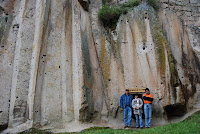The Fangs of the Serpent
 The Haquira Prison of the Holy Inquisition
The Haquira Prison of the Holy Inquisition Entrance to the Judicial Chambers
Entrance to the Judicial ChambersExactly what to call this I am not sure. I passed through the town of Haquira, Peru the other day. I was accompanied by four people with whom I work and we decided to stop and have a look at the prison that had been constructed in the large, columnar-jointed, welded-tuff massif in the middle of the town. It probably started as an Inca prison, but that would have only been a holding tank until they got around to executing them. They did not spend a lot of time on prisons since lying, stealing and laziness were all capital crimes in their world, let alone bigger stuff. Peruvians like to blame stuff on the Inca that should more likely be laid at the feet of the Spanish and the Holy Inquisition.
 The Smallest Cell of the Men's Prison
The Smallest Cell of the Men's PrisonThis prison consists of two cave-like rooms carved into the living rock. One cave/prison cell set was built for the women and the other for the men. The men’s prison consists of three cells separated by a tiny door that I had to crawl through and openings into increasingly smaller spaces the deeper you go. The final space was impossible to stand in, even for the shorter Peruvians in my group. There was no light even with the doors open. On the women’s side, these deeper reaches have been covered over by the massive stone door that slipped into place in an earthquake some years back and no one can figure out how to get it back up.
The deep recesses were reserved for those who had committed the worst crimes. Those guilty of simple errors were able to walk out into the light of day from time to time. The place was dank, cold and humid but has not been inhabited for over a hundred years so there is no presence of human body odor now.
For as horrible as this was, there still awaited the purely Spanish touch up the stairs to the judgment chamber that says, “Holy Inquisition Tribunal of Justice.” It is a typical courtroom with benches carved into the stone on either side where judges and lawyers sat along with the accused. In the front is a judge’s seat where the tribunal president sat and a balustrade across, in front of his seat.
 The Judicial Chamber
The Judicial ChamberThe one departure from the typical court room is a large hole, about the size of a basket ball in the ceiling above the left side of this balustrade. In this there is a hole that runs through the rock to the surface outside. Through this hole they passed a noose, anchored to the outside. Those who simply would not recant were hanged by placing their head up in the hole and having the noose tightened around their neck and a small stool kicked out from under their feet.
The place is maintained and tidy now with a gate keeper who charges s/.5 to get in and some little children serve as guides having been steeped in the history. Some will say that it is just history after all... In a way, it is kind of a beautiful monument to the brutality and horror that was waged against humanity by the Papacy in those years, not all that different from what the Nazis did though it lasted much, much longer. Still, should anyone ever doubt the doctrine of the Great Apostasy, he only needs to spend a little time in a place like this where the long gloomy night of the dark ages caused such massive human suffering. In the words of Bruce R. McConkie in his great talk on the restoration of the Gospel,
“It was a long, dark night. There were jackals in the shadows, wolves in the forests, coyotes everywhere. Lions roared and the fangs of the serpent sank again and again into human flesh. The black plague swept Europe. Wars were everywhere. Morality and decency had few supporters. The terrors of the night were real and the night was long—long and dark and black.”
Indeed!


0 Comments:
Post a Comment
<< Home